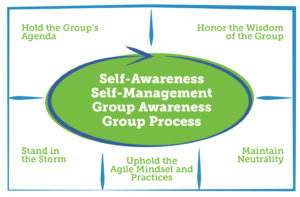Leaders, is your team scattered across the nation, or the globe? Are you struggling to keep your team focussed, cohesive and productive? Whether your team is virtual due to the recent coronavirus pandemic or had been a virtual team by-design, facilitating a team remotely is easy in concept, but more challenging in reality.
Fortunately, TeamCatapult has been in the remote work and remote team facilitation space for a long time! We have experience in this space and have been conducting Virtual Team Facilitation workshops for years.
While attending a recent workshop, attendee Lisa from Get The Picture created this incredible resource for virtual team leaders. This is what was discussed and learned on Day1. At first blush, it’s probably hard to land on a starting point. We’ve outlined some salient points that touch on the flow of the workshop.

Getting Started With Virtual Team Facilitation
The first thing to do when facilitating a virtual team meeting is to reduce distractions. We recommend that attendees do one or all of these:
- Silence their phone
- Shut the door
- Close their email tab
While your team members take care of these things on their end, you as the facilitator should take care of some business as well!
Tips for the Virtual Team Facilitator
1 Display a Welcome Screen
This assures everyone has come to the right place. This also makes everyone feel welcome.
2 Use a Slack channel for Parking Lot
Be sure to clear it out by the end of the day! If you are unfamiliar with this term, the ‘Parking Lot’ is where you post follow up questions and discussions that might lead you on a path away from what you are teaching at the moment.
Noting the responses and answers about any of the items and ‘clearing’ them at the end of the day validates the importance of questions without cutting into the formal workshop time.
3 Use a Virtual Circle in Mural to Open
You can use photos of attendees, and invite people to ‘sit next to someone’. Once everyone is seated in the circle (virtual) take time for everyone to introduce themselves. Again, this helps new attendees feel welcome and wanted.
4 Use Breakout Rooms in Zoom
Ask people to reach you in Slack if you are needed during the breakout session. Zoom breakout rooms are a great way to have small group discussions among attendees. We use these rooms so teams can work on simulations while capturing notes in Mural.
Timezones, Technology and Ground Rules
There are things that can go wrong when using technology, from the challenge of varying time zones, to not being able to connect, to having unstable Wifi. Expect these issues, but be sure to set ground rules!
Set and Scribe Ground Rules
- Be in a quiet place
- Be off mute
- Be on video
- Be on time
- Pay attention
Ask: ‘What do you need of me?’ and ‘What do you need of each other?’
Include ways to handle collisions. For example – be clear how you will handle two people speaking at once. It does happen so have a plan in place from the beginning.
Low Stakes Virtual Team Facilitation
Often times meetings can get into a “high-stakes” atmosphere, where there are, simply put, conflicts within the team on an issue. The question for a facilitator is how will you slow things down and make it feel low stakes and safe to continue on with the conflict?
Here are three solutions:
- Narrate
- Chunk instructions
- Normalize
Use Question Prompts to Incite Curiosity
Get people outside of their normal ways of thinking about their work! Using question prompts gets attendees to open up and participate and move beyond what’s may have them stuck on how to talk about and resolve a topic.
Virtual Team Facilitation Design Tips!
Here are 3 design tips that might help you organize your next virtual meeting.
- Resist the urge to jump to tools
- Test… is a meeting actually needed?
- Use offline time to do work!
Learn More About Virtual Team Facilitation!
To find out more about Virtual Team Facilitation, check out what Lisa learned on Day 2 of the Virtual Team Facilitation Workshop!
We are grateful for Lisa’s willingness to share these visuals with you, our audience, to provide you with a glimpse into the world of Virtual Team Facilitation
Whether it is you, your leadership team, or your company that needs help with Virtual Team Facilitation, TeamCatapult is able to lend a hand.
Please contact us today for more information for both private and public Virtual Facilitation Masterclass workshops.

